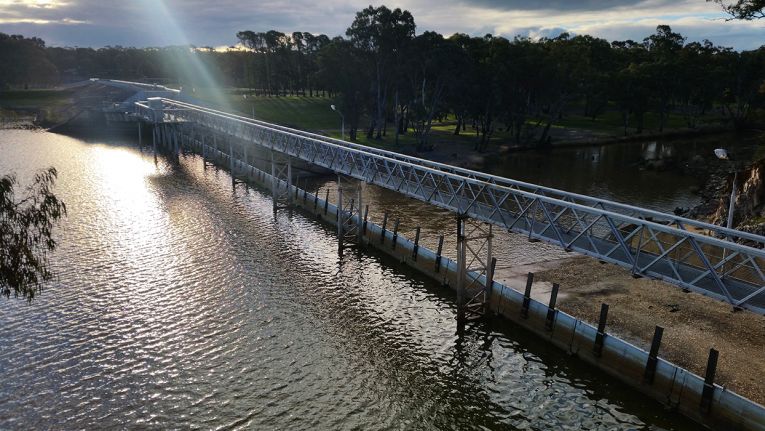
Laanecoorie is a beautiful little town within the Loddon Shire, part of the Victorian Goldfields. The town is well known for the gorgeous Laanecoorie Reservoir and the fantastic picnic, camping and recreation facilities which surround it.
The Loddon River connects to the Laanecoorie Reservoir, and along its banks you will find an excellent campground and picnic area - the Laanecoorie River Recreation Reserve.
You can take a short, easy bushwalk from the campground to the Laanecoorie Reservoir Weir, which offers spectacular views out over Laanecoorie.
Brownbill Reserve lies on the other side of the reservoir - a popular spot for picnics, boating, fishing and swimming.
Ankers Causeway is a little further around the reservoir and offers a basic picnic area and a boat ramp.

Laanecoorie Reservoir is a popular destination for camping, fishing, swimming, boating and picnics.
Fishing
The Laanecoorie Reservoir is stocked regularly with Golden Perch and occasionally with Brown Trout. Murray Cod can also be caught in shallow areas. Try fishing for them at night with surface lures. The Loddon River is also home to many varieties of fish including Redfin, Tench, Goldfish and Carp.
Swimming
Swimming is a popular activity at Laanecoorie, with excellent swimming spots all around the reservoir and along the Loddon River.
Boating
There are multiple boat ramps available around Laanecoorie Reservoir:
Camping
There is a fantastic riverside campground at Laanecoorie, the Laanecoorie River Recreation Reserve. This is a popular spot for both tents and RVs with plenty of space, lovely views, boat ramp, picnic facilities and toilets. You can also find powered and unpowered sites at the nearby Laanecoorie Lakeside Park.

Camp alongside the beautiful Loddon River at the Laanecoorie River Recreation Reserve.
Walking
Walk from the Laanecoorie River Recreation Reserve to the nearby Laanecoorie Weir.
- Take some time to appreciate the elegance of the Janevale Bridge, a reinforced concrete structure designed and constructed by Sir John Monash and completed in 1911.
- As you wander through the Floodplains Riparian Woodland on the banks of the Loddon River, notice the variety of shrubs, grasses, herbs, rushes and reeds that flourish in the absence of grazing animals. These plants and the riverine environment provide perfect habitat for a variety of fish, birds, reptiles, amphibians and mammals.
- The Laanecoorie weir serves to regulate water flows used for irrigation and town supply further down the Loddon River. It was completed in 1891 and, though it has been reduced in capacity due to siltation over the years, provides a valuable storage and recreational facility.
- Along Weir Road you may notice a change in the vegetation as the Yellow Gum trees become dominant. Halfway along the walk the bottle-trunked tree with bright green foliage is a Kurrajong.
(Source: information sign at the Laanecoorie River Recreation Reserve)
HISTORY OF LAANECOORIE
By courtesy of La Trobe Library. Written by D.R.Mac Lellan head teacher 1918-1919.
In 1840 the first company of white men messrs, Simson, Dutton and Darling crossed the Loddon, and took up land here for a sheep run. It was called Janevale after Simson's wife. Laanecoorie was at this time the headquarters of a big tribe of blacks, who lived along the banks of the Loddon River, on the fine stretch of water now reaching from the weir to Mr Michaels. This is the longest water hole on the Loddon River. The blacks called it Languycoorie, which means long water hole hence the name Laanecoorie. The blacks were very treacherous, and killed many of the station hands. In 1850 Mr Cay leased a large acreage for sheep and cattle run. He built his homestead near where Mr Dicken's house now stands. There were about 40,000 sheep and 2,000 head of cattle on this run. These were supervised by Mr Michael, whose sons and grandsons still reside in the district and a number of shepherds, one of whom was speared and killed by the blacks. The country was at this time an immense forest, excepting on the river flats and the plain where Mr Spedding now resides. In 1855 Mr W Waugh who is now in his 93rd year and Laanecoorie's oldest living resident, passed through here on his way to the gold rush at Jones creek. He was fairly successful there, and next year, when returning was persuaded by Mr Cay to take a position on the station so he brought his family here, and remained in the Employ of Mr Cay til 1862, when he bought the property now owned by Mr A Smith.
The first farm selected was by the Lyon Brothers, of whom Mr W Lyons still resides on the property. They took up their present property in 1857 and by 1860 many had other settlers arrived and purchased farms. Mr Edward Stone who arrived in 1857 had the honour of growing the first crop on land now owned by his son. He followed chiefly the occupation of a gardener and his orchard, vineyard and vegetable garden were the first in these parts. He took a keen interest in local affairs, and was, with his friend Thomas Langdon, one of the founders of the school, which was opened in 1864. Its first teacher was Mr D Ryland, who occupied the position till his death in 1871. The old building still stands in the grounds of the present of the up to date building, which was erected in 1906. It was around this building that the township was first formed and near it in 1869 the present Methodist church was built. Previous to 1870 the river was crossed by a punt, but in 1870 the first bridge was built over the Loddon, and this caused a settlement to form near it. A hotel and a blacksmith shop were erected near it by Mr T Grisold, and Thomas and Comrie then built a grocer's shop adjacent to these. In 1890 the construction of the weir was started by the Deakin-Gillies group. It took three years to complete. The building cost £80,000, and £90,000 paid in compensation to farmers whose land it ruined. It was the first structure of its kind in Victoria. In 1909 it was partially destroyed by a great flood but was repaired and a large by wash constructed. This flood at the same time destroyed the old bridge, and this has now been replaced by a fine concrete construction.


